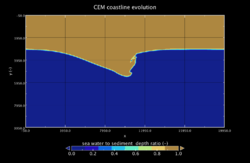Lab-0007
River-Delta Interactions
Contributor(s)

Classroom organization
The Coastline Evolution Model (CEM) addresses predominately sandy, wave-dominated coastlines on time-scales ranging from years to millenia and on spatial scales ranging from kilometers to hundreds of kilometers. Shoreline evolution results from gradients in wave-driven alongshore sediment transport. The model has been used to represent varying geology underlying a sandy coastline and shoreface in a simplified manner and enables the simulation of coastline evolution when sediment supply from an eroding shoreface may be constrained. CEM also supports the simulation of human manipulations to coastline evolution through beach nourishment or hard structures. To learn more about the models in this lab, specifically the Coastal Evolution Model, CEM, you can download the presentation.
This lab includes experiments to couple the terrestrial and coastal domains. We will be looking at a river supplying sediment to a coastal zone, along which wave-driven longshore transport occurs. We will learn about the effect of incoming wave fields, the effect of sediment supply to the coast, and whether this supply happens through a single delta channel or multiple delta channels. Many deltas are classified as wave-dominated deltas, the Arno Delta in Italy is one example.
This lab can be run on either the lab (for educators) or jupyter (for general use) instance of the OpenEarthscape JupyterHub: just click one of the links under the Run online using heading at the top of this page, then run the notebook in the "CSDMS" kernel.
If you don't already have a JupyterHub account, follow the instructions to sign up at https://csdms.colorado.edu/wiki/JupyterHub. If you're an educator, you can get JupyterHub accounts for students--please contact us through the CSDMS Help Desk: https://csdms.github.io/help-desk.
Download associated file: CoupledAvulsionCEMWMTversion.pptx
A presentation on using the CEM model.
Skills
- Use pymt to run the CEM model
- Become familiar with a basic configuration of the CEM model
- Make small changes to key input parameters in CEM
- Gain hands-on experience with visualizing output in Python
- Generate a wave-dominated delta
- Explore the influence of wave conditions (e.g., wave height, wave angle) on delta formation
- Explore the influence of river input on delta formation
Lab notes
Instead of downloading the lab Notebook and running it locally, or running it through the CSDMS JupyterHub, you can also run it on Binder. Follow these steps:
>> Open a new browser window and go to: https://pymt.readthedocs.io/en/latest/examples.html
>> You will see that there are several example models. In this lab we will select the Coastline Evolution Model.
>> Click on the "Launch Binder" button to run this lab.
Note that Binder is a free and popular service for running Jupyter Notebooks, so it can be slow to load at times.
CEM is run with the Python Modeling Tool, pymt. Learn more about pymt at: https://pymt.readthedocs.io.Requirements
If run locally, this lab requires the installtion of pymt; see https://pymt.readthedocs.io/en/latest/quickstart.html for instructions. This lab runs on Linux and macOS.
Acknowledgements
This material is based upon work supported by the National Science Foundation under Grant No. 1831623, Community Facility Support: The Community Surface Dynamics Modeling System (CSDMS).
References
- Ashton, A, A.B. Murray, and O. Arnoult. 2001. Formation of coastline features by large-scale instabilities induced by high-angle waves. Nature 414: 296-300., doi: 10.1038/35104541
- Ashton, A.D. and Murray, A.B., 2006. High-angle wave instability and emergent shoreline shapes: 2. Wave climate analysis and comparisons to nature. Journal of Geophysical Research 111. F04012., doi: 10.1029/2005JF000423

